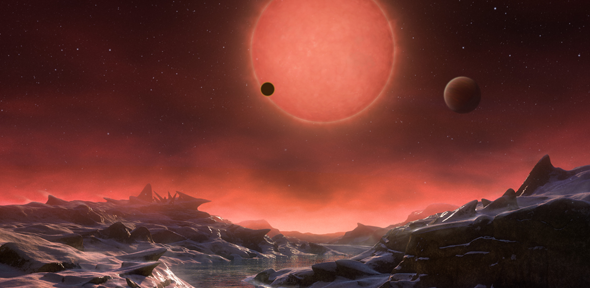
An international team of astronomers has discovered three planets orbiting an ultracool dwarf star just 40 light years from Earth. These worlds have sizes and temperatures similar to those of Venus and Earth and may be the best targets found so far for the search for life outside the Solar System. They are the first planets ever discovered around such a tiny and dim star. The results are reported in the journal Nature.
Using the TRAPPIST telescope at the European Southern Observatory’s (ESO) La Silla Observatory in Chile, the astronomers observed the star 2MASS J23062928-0502285, now also known as TRAPPIST-1, and located in the Aquarius constellation. They found that this dim and cool star faded slightly at regular intervals, indicating that several objects were transiting, or passing between the star and the Earth. Detailed analysis showed that three planets with similar sizes to the Earth were present.
TRAPPIST-1 is an ultracool dwarf star — much cooler and redder than the Sun and barely larger than Jupiter. Such stars are very common in the Milky Way and very long-lived, but this is the first time that planets have been found around one of them. Despite being so close to the Earth, this star is too dim and too red to be seen with the naked eye or even with a large amateur telescope.
“The discovery of a planetary system around such a small star opens up a brand new avenue for research,” said Professor Didier Queloz from the University of Cambridge’s Cavendish Laboratory, the paper’s senior author. “Before this discovery it was not at all clear whether such a small star could host an Earth-sized planet. Nobody had seriously studied it, but now that’s likely to change.”
“Systems around these tiny stars are the only places where we can detect life on an Earth-sized exoplanet with our current technology,” said the paper’s lead author Michaël Gillon, from the University of Liège in Belgium. “So if we want to find life elsewhere in the Universe, this is where we should start to look.”
Astronomers will search for signs of life by studying the effect that the atmosphere of a transiting planet has on the light reaching Earth. For Earth-sized planets orbiting stars similar to our Sun this tiny effect is swamped because of the large size ratio between the planet and the star. Only for the case of faint red ultra-cool dwarf stars — like TRAPPIST-1 — is this effect big enough to be detected.
Follow-up observations with larger telescopes have shown that the planets orbiting TRAPPIST-1 have sizes very similar to Earth. Two of the planets complete an orbit of the star in 1.5 days and 2.4 days respectively, and the third planet has a less well determined orbital period in the range of 4.5 to 73 days.
“With such short orbital periods, the planets are between 20 and 100 times closer to their star than the Earth to the Sun,” said Gillon. “The structure of this planetary system is much more similar in scale to the system of Jupiter’s moons than to that of the Solar System.”
Although they orbit very close to their host dwarf star, the inner two planets only receive four and two times, respectively, the amount of radiation received by the Earth, because their star is much fainter than the Sun. That puts them closer to the star than the habitable zone for this system. The third, outer, planet’s orbit is not yet well known – it probably receives less radiation than the Earth does, but perhaps still enough to lie within the habitable zone.
The next generation of giant telescopes, such as NASA’s James Webb Telescope due to launch in 2018, will allow researchers to study the atmospheric composition of these planets and to explore them first for water, and then for traces of biological activity.
“While this is not the first time that planets have been found in the habitable zone of a star, the TRAPPIST-1 system provides humanity with our first opportunity to remotely explore Earth-like environments and empirically determine their suitability for life,” said study co-author Dr Amaury Triaud from Cambridge’s Institute of Astronomy. “Because the system contains many planets, we will even be able to compare the climates of each to one another and to the Earth’s.”
This work opens up a new direction for exoplanet hunting, as around 15% of the stars near to the Sun are ultra-cool dwarf stars, and it also serves to highlight that the search for exoplanets has now entered the realm of potentially habitable cousins of the Earth. The TRAPPIST survey is a prototype for a more ambitious project called SPECULOOS that will be installed at ESO’s Paranal Observatory in Chile.
Reference:
Michaël Gillon et al. ‘Temperate Earth-sized planets transiting a nearby ultracool dwarf star.’ Nature (2016). DOI: 10.1038/nature17448
Adapted from an ESO press release.
Three Earth-sized planets have been discovered orbiting a dim and cool star, and may be the best place to search for life beyond the Solar System.

The text in this work is licensed under a Creative Commons Attribution 4.0 International License. For image use please see separate credits above.
















